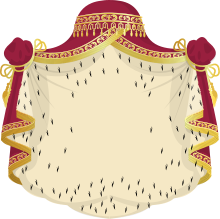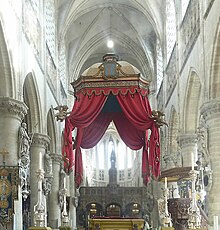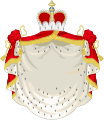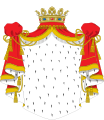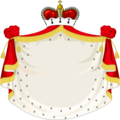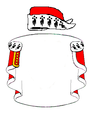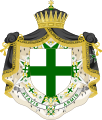
Heraldry is a discipline relating to the design, display and study of armorial bearings, as well as related disciplines, such as vexillology, together with the study of ceremony, rank and pedigree. Armory, the best-known branch of heraldry, concerns the design and transmission of the heraldic achievement. The achievement, or armorial bearings usually includes a coat of arms on a shield, helmet and crest, together with any accompanying devices, such as supporters, badges, heraldic banners and mottoes.
Fürst is a German word for a ruler as well as a princely title. Fürsten were, starting in the Middle Ages, members of the highest nobility who ruled over states of the Holy Roman Empire and later its former territories, below the ruling Kaiser (emperor) or König (king).

In heraldry, the field (background) of a shield can be divided into more than one area, or subdivision, of different tinctures, usually following the lines of one of the ordinaries and carrying its name. Shields may be divided this way for differencing or for purposes of marshalling, or simply for style. The lines that divide a shield may not always be straight, and there is a system of terminology for describing patterned lines, which is also shared with the heraldic ordinaries.

A coronet is a small crown consisting of ornaments fixed on a metal ring. A coronet differs from other kinds of crowns in that most coronets do not have arches, and from a tiara in that a coronet completely encircles the head, while a tiara does not.

In heraldry, cadency is any systematic way to distinguish arms displayed by descendants of the holder of a coat of arms when those family members have not been granted arms in their own right. Cadency is necessary in heraldic systems in which a given design may be owned by only one person at any time, generally the head of the senior line of a particular family.

In heraldry, an escutcheon is a shield that forms the main or focal element in an achievement of arms. The word can be used in two related senses. In the first sense, an escutcheon is the shield upon which a coat of arms is displayed. In the second sense, an escutcheon can itself be a charge within a coat of arms.

In heraldry, a torse or wreath is a twisted roll of fabric laid about the top of the helmet and the base of the crest. It has the dual purpose of masking the join between helm and crest, and of holding the mantling in place.

The coat of arms of the Kingdom of the Netherlands was originally adopted in 1815 and later modified in 1907. The arms are a composite of the arms of the former Dutch Republic and the arms of the House of Nassau, it features a checkered shield with a lion grasping a sword in one hand and a bundle of arrows in the other and is the heraldic symbol of the monarch and the country. The monarch uses a version of the arms with a mantle while the government of the Netherlands uses a smaller version without the mantle (cloak) or the pavilion, sometimes only the shield and crown are used. The components of the coats of arms were regulated by Queen Wilhelmina in a royal decree of 10 July 1907, affirmed by Queen Juliana in a royal decree of 23 April 1980.

The lion is a common charge in heraldry. It traditionally symbolises courage, nobility, royalty, strength, stateliness and valour, because historically the lion has been regarded as the "king of beasts". The lion also carries Judeo-Christian symbolism. The Lion of Judah stands in the coat of arms of Jerusalem. Similar-looking lions can be found elsewhere, such as in the coat of arms of the Swedish royal House of Bjelbo, from there in turn derived into the coat of arms of Finland, formerly belonging to Sweden.

Ecclesiastical heraldry refers to the use of heraldry within Christianity for dioceses, organisations and Christian clergy. Initially used to mark documents, ecclesiastical heraldry evolved as a system for identifying people and dioceses. It is most formalized within the Catholic Church, where most bishops, including the pope, have a personal coat of arms. Clergy in Anglican, Lutheran, Eastern Catholic and Eastern Orthodox churches follow similar customs, as do institutions such as schools and dioceses.

A crown is often an emblem of a sovereign state, usually a monarchy, but also used by some republics.
In the British peerage, a royal duke is a member of the British royal family, entitled to the titular dignity of prince and the style of His Royal Highness, who holds a dukedom. Dukedoms are the highest titles in the British roll of peerage, and the holders of these particular dukedoms are princes of the blood royal. The holders of the dukedoms are royal, not the titles themselves. They are titles created and bestowed on legitimate sons and male-line grandsons of the British monarch, usually upon reaching their majority or marriage. The titles can be inherited but cease to be called "royal" once they pass beyond the grandsons of a monarch. As with any peerage, once the title becomes extinct, it may subsequently be recreated by the reigning monarch at any time.

English heraldry is the form of coats of arms and other heraldic bearings and insignia used in England. It lies within the so-called Gallo-British tradition. Coats of arms in England are regulated and granted to individuals by the English kings of arms of the College of Arms. An individual's arms may also be borne 'by courtesy' by members of the holder's nuclear family, subject to a system of cadency marks, to differentiate those displays from the arms of the original holder. The English heraldic style is exemplified in the arms of British royalty, and is reflected in the civic arms of cities and towns, as well as the noble arms of individuals in England. Royal orders in England, such as the Order of the Garter, also maintain notable heraldic bearings.

In heraldic achievements, the helmet or helm is situated above the shield and bears the torse and crest. The style of helmet displayed varies according to rank and social status, and these styles developed over time, in step with the development of actual military helmets. In some traditions, especially German and Nordic heraldry, two or three helmets may be used in a single achievement of arms, each representing a fief to which the bearer has a right. For this reason, the helmets and crests in German and Nordic arms are considered essential to the coat of arms and are never separated from it.

In heraldry, an achievement, armorial achievement or heraldic achievement is a full display or depiction of all the heraldic components to which the bearer of a coat of arms is entitled. An achievement comprises not only the arms displayed on the escutcheon, the central element, but also the following elements surrounding it :
Heraldic labels are used to differentiate the personal coats of arms of members of the royal family of the United Kingdom from that of the monarch and from each other. In the Gallo-British heraldic tradition, cadency marks have been available to "difference" the arms of a son from those of his father, and the arms of brothers from each other, and traditionally this was often done when it was considered important for each man to have a distinctive individual coat of arms and/or to differentiate the arms of the head of a house from junior members of the family. This was especially important in the case of arms of sovereignty: to use the undifferenced arms of a kingdom is to assert a claim to the throne. Therefore, in the English royal family, cadency marks were used from the time of Henry III, typically a label or bordure alluding to the arms of the bearer's mother or wife. After about 1340, when Edward III made a claim to the throne of France, a blue label did not contrast sufficiently with the blue field of the French quarter of the royal arms; accordingly most royal cadets used labels argent: that of the heir apparent was plain, and all others were charged. Bordures of various tinctures continued to be used into the 15th century.

The Eastern Crown is a gold heraldic crown surmounted with a variable number of sharp spikes. It is so called because of its origin in the Eastern Mediterranean. The Eastern Crown is one of the oldest crowns, and so for this reason it has also been known as the Antique Crown.
A national coat of arms is a symbol which denotes an independent state in the form of a heraldic achievement. While a national flag is usually used by the population at large and is flown outside and on ships, a national coat of arms is normally considered a symbol of the government or the head of state personally and tends to be used in print, on armorial ware, and as a wall decoration in official buildings. The royal arms of a monarchy, which may be identical to the national arms, are sometimes described as arms of dominion or arms of sovereignty.

The coat of arms of the Prince of Wales is the official heraldic insignia of the Prince of Wales, a title traditionally granted to the heir apparent of the reigning monarch of the United Kingdom of Great Britain and Northern Ireland, formerly the Kingdom of Great Britain and before that the Kingdom of England.

Heraldry is the system of visual identification of rank and pedigree which developed in the European High Middle Ages, closely associated with the courtly culture of chivalry, Latin Christianity, the Crusades, feudal aristocracy, and monarchy of the time. Heraldic tradition fully developed in the 13th century, and it flourished and developed further during the Late Middle Ages and the Early Modern period. Originally limited to nobility, heraldry is adopted by wealthy commoners in the Late Middle Ages. Specific traditions of Ecclesiastical heraldry also develop in the late medieval period. Coats of arms of noble families, often after their extinction, becomes attached to the territories they used to own, giving rise to municipal coats of arms by the 16th century.
